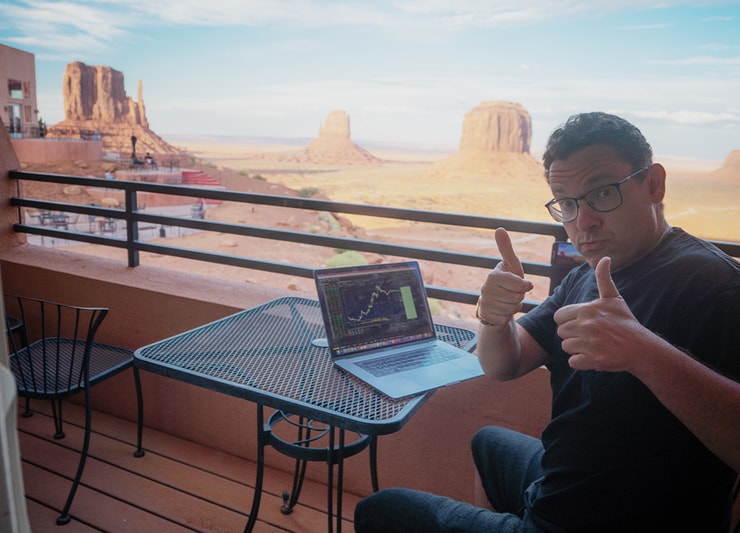Morning panic dip buys are one of my FAVORITE trades.
It’s one of my most consistent setups, helping me achieve a +75% win rate.
I’ve used this same pattern for more than two decades.
But the crazy thing is the average trader doesn’t know how to spot it, let alone how to take advantage of it.
However, since you’re reading this I know you’re not the average trader.
And since you’re working on elevating your game, I’m going to do my part and share with you how I turn this pattern into profits.
Premarket Movers & Gainers

The first place I look for potential morning panic dip buys are amongst the premarket movers.
These are the stocks with the largest percentage gains in the premarket, which stretches from 4:00 a.m. to 9:30 a.m. est.
I will also look at stocks that jumped after the market closed at 4:00 p.m. est the day before.
Now, you won’t find most of these stocks on CNBC or major news networks. They’ll be focused on well-known companies, which isn’t what I’m interested, and I’ll explain why a bit later.
I want those random penny stocks that trade under $5.00 surging 50%, 100%, 200%…really eye-popping numbers.
However, these shouldn’t be random. Any stock can look like it’s up a ton if an errant trade or two executes.
No, I’m looking for stocks that are moving on news and important headlines with real meat and heft to it that’s timely.
Here are a few examples:
- Earnings
- Clinical data results or FDA approvals
- Landing a big customer order
- Non-dillutive capital raise
Without a headline, you’re trading solely on price action, putting you at the whims of chat pumps and other actors who can pull the rug out at a moment’s notice.
Bigger Moves = Bigger Bounces

When the S&P 500 crashed in 2020, it took more than a month for it to drop 34%.
Bigger stocks tend to be less volatile than smaller stocks.
Volatility is what creates bounces.
Sure, you could take larger positions on less volatile stocks to compensate for the smaller bounces.
But I find them far less reliable.
Instead, I like small caps with lower floats and OTC stocks.
These stocks tend to be more thinly traded (IE see less volume on average). So, when big orders hit, the stock can jump or fall by dozens of percentage points.
Here’s an example from last Thursday.
This tiny stock with a 13 million float jumped in the premarket when news dropped about them financing shares at $1.35 per share.
Typically, Datasea Inc. (NASDAQ: DTSS) trades 100,000 shares a day.
They passed that amount within two minutes of the news drop.
Although the stock was only up $0.27, that’s almost 50%!
So, when it dropped back down to $0.70, a little less than 20% off the highs, I took a shot at a dip buy.
As I had hoped, shares rallied almost 10% where I exited for a nice little profit.
Here’s a more extreme example.
Renovaro Biosciences (NASDAQ: RENB) skyrocketed in the premarket.
This stock went from $0.875 to $3.375 on a news release – a 285% jump in minutes!
I bought the stock when it dropped back to $1.46, more than 50% off its highs.
I managed to sell at 1.57, a nice little 7.5% gain.
More Breaking News
- Opendoor Technologies’ CEO Stock Sale Sparks Speculation Amid Stock Volatility
- Quantum Computing’s Market Tumble: What’s Fueling the Descent?
- International Seaways Ready for S&P SmallCap 600: Is the Stock Set to Skyrocket?
Connecting the Dots

For some of you, morning panic dip buys might look like I’m trying to catch a falling knife.
Heck, I’m trying to pick off 5%-10% on a stock that’s moving almost 300%.
But +75% win rate, a profitable track record, and more than two dozen millionaire students probably means there’s more here than meets the eye.
You want to know the secret?
The truth is I don’t use anything complicated or fancy.
In fact, many of you probably already have the skills necessary to trade exactly like this.
It’s a lot simpler than you realize.
You just don’t know how to put it all together.
I understand if you’re a bit skeptical. After all, if it was this easy, why doesn’t everyone do it?
So let me prove it to you.
Sign up for my next LIVE STRATEGY SESSION, and I’ll show you how I teach folks to take all these different skills and ideas and turn them into reliable trading strategies.



Leave a reply